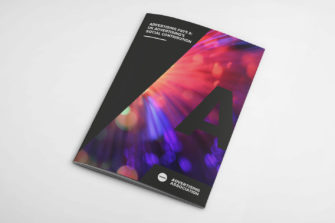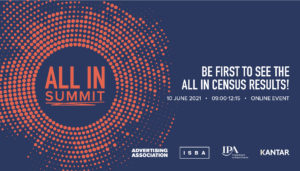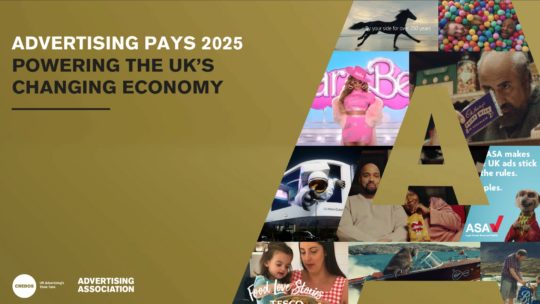‘How does advertising work?’ written by Paul Feldwick
Advertising may influence behaviour through signposting, salesmanship, seducing, shaping social reality, and simply creating fame. #AdBigQs
A blind man was begging on Madison Avenue. In front of him was a handwritten sign – ‘I AM BLIND’ – and a cup containing just two cents. A passing copywriter asked to add a few more words. When, at the end of the day, the copywriter passed again, the cup was full. ‘What did you write?’ the blind man asked. The copywriter had added just four words: ‘IT IS SPRING AND I AM BLIND’.
The story may be apocryphal, but it suggests at least one difficulty when answering the question ‘How does advertising work?’ The idea of advertising as rational argument seems inadequate here, even though the sign states nothing but simple facts. Even the original, ‘I AM BLIND’, shows the impossibility of separating advertising into ‘information’ and ‘persuasion’. Psychologists might attempt to provide explanations, but perhaps we also need the language of rhetoric, or even art, when trying to explain why the choice of just a few words might prove so motivating.
But advertising encompasses far more than a few words, as Pierre Martineau pointed out in 1957: “Modern advertising is not just a posting of claims, a bare-bones statement of fact. It is far, far, from being just a reliance on words and logic. It is rather a fusion of many modes of human communications, including language. Advertising as we know it today uses layout and illustration, both photography and art; it uses colour and music, even choreography and drama…so much more is going on than just a sales argument with the consumer.”
From signposting…
Advertising probably began as simple signposting. One of the oldest ‘ads’ we know of is a first-century carving on the quay at Ephesus, directing sailors to the local brothel. With printing, the ‘signposting’ became more sophisticated; it became a way of putting sellers in touch with buyers, employers in touch with jobseekers, Miss Lonely Heart in touch with Mr Right. Such paid-for notices filled the classified columns of the press from the 17th century onwards. And the Internet, of course, is an even better medium for signposting.
But wherever signposting becomes more common, and therefore more competitive, it inevitably develops into both a fight for attention and a sales pitch. Three hundred years ago, Joseph Addison was reflecting facetiously in The Tatler on the devices that advertisers in his magazine used to get their own message noticed, and the high-flown language they adopted to make their products desirable.
…to selling
So signposting soon turns into selling, and analogies of selling have dominated much thinking about advertising. The 1880s salesmen’s mnemonic, AIDA – ‘getting ATTENTION – attracting INTEREST – creating DESIRE – closing with ACTION’ – was linked to advertising in 1904 when a copywriter, John E. Kennedy, defined advertising as ‘salesmanship in print’, arguing that an advertiser, like any shopkeeper, must give credible ‘reasons why’ his product should be preferred. These principles work best in direct response advertising. Simple headlines ‘hailing a few people only’, and long, factual copy avoiding humour or ‘eccentricity’ have long been the most effective ways of selling off the page, and still generally are today, in print, ‘infomercial’ TV, or online.
Versions of this ‘salesmanship’ model have tended to dominate thinking around advertising ever since. It’s commonly assumed that, to be effective, advertising must capture conscious attention, then transmit a persuasive ‘sales message’, and, if necessary, lodge this message in the consumer’s memory. Popular language and research techniques both reflect this model, emphasising ‘attention’, ‘standout’, ‘consumer benefits’, ‘reasons why’, ‘message’, ‘proposition’, ‘credibility’, ‘comprehension’, ‘message recall’, etc.
Subconscious effects
These assumptions are only partially correct, however. Psychologist Walter Dill Scott observed as early as 1903 that advertising can be effective without attracting conscious attention or being consciously recalled. Many successful ads don’t appear to contain a ‘message’ at all, and even if they do, a great deal else is often happening in the ad that seems to be more important. Some experts even argue that advertising is often more effective when it is not consciously noticed or processed; when we don’t notice we are being influenced, we cannot argue back.
The idea that advertising influences us subconsciously has often caused alarm – the classic fear of the ‘Hidden Persuaders’. But, today, evidence from psychology and neuroscience that shows that this is how much advertising works is overwhelming. We might find this less disturbing if we accept that this is not just true of advertising, but of everything: our responses to people we meet, to shops and other places we visit, and to stories we see on the news are all influenced by signals and associations we are often unconscious of, just as our preferences and prejudices are usually learnt in ways we don’t notice.
If a large part of advertising’s influence is unconscious, that also makes it harder to explain in words quite how and why it works. We think we know how we are being influenced when someone gives us persuasive facts or arguments. But why should silly films of talking animals, or people singing songs, or a cartoon on a poster site increase our propensity to buy one brand rather than another?
To answer this, we need first to be clear on what kind of behavioural changes advertising brings about. Advertising as a sales pitch suggests a one-off transaction, as well as a conscious decision: I read an ad, I am persuaded, and I apply for the job or order the merchandise, and the process is complete. And some ads do work like this, either as a direct response or some form of ‘sales activation’, converting a potential buyer into an actual buyer by facilitating the transaction in some way. (Again, the Internet is well-adapted to this.) But there’s also a great deal of advertising that is remote in time and place from the point of sale, and which sets out to influence people who are already aware of the brand advertised – and who may have bought it many times before – and this is doing something different. It’s not so much creating a sale as increasing ‘saleability’.
When purchasing panel data became widely available in the 1960s, it showed, across all categories, that the traditional picture of advertising converting loyal users of Brand A to Brand B was largely false, because users of a category generally buy a whole repertoire of brands. Then single source panels, which record both ad exposure and purchase behaviour for the same individuals, demonstrated that, for about half of all campaigns, a single exposure to an ad during the purchase interval creates an increased likelihood of buying the advertised brand. Because of this repeated ‘nudging’ effect, advertising achieves best results on market share when it maintains a continuous presence and a sufficient weight relative to competition. (We also know this to be largely true because brands, on average, gain or lose share of market when their ‘share of voice’ becomes larger or smaller.)
While these small, incremental influences on behaviour are individually trivial, over time they can create a long-term shift in demand for the advertised brand, leading to increased market share, increased price premium and therefore profitability, and resilience to competition. Analysis of advertising case histories has shown that, while short-term ‘sales activation’ is both effective and necessary, only repetitive brand advertising has long-term, cumulative effects on the competitive strength of the brand.
This ‘brand-building’ advertising seems more likely to depend on partially unconscious psychological processes than the more rational arguments of sales activation advertising (which is why people are very seldom aware that they have been influenced by advertising). Let us now return to what these psychological processes might be like.
One surprisingly simple, but fact-based, hypothesis for how advertising creates such effects has been recently proposed. According to Byron Sharp, all advertising does is increase ‘mental availability’ for a brand: salience, or top-of-mind awareness. To do this, it need not have any explicitly ‘persuasive’ content or argument; it need not even create any meaningful differentiation between one brand and another. All that the creative execution needs to achieve is to create and maintain distinctive ‘brand assets’ (characters, imagery, design, jingles, slogans, etc.) uniquely linked to the brand, and keep them top of mind. Advertising need not contain a ‘message’, nor achieve any meaningful differentiation between brands (consumers see competing brands as more similar than different anyway); it need only create the ‘meaningless distinctive’.
Not everyone accepts this radical view, but it fits with much of the evidence, and probably explains more about how advertising works than its critics like to admit. Brand assets sometimes begin as dramatisations of product claims, and may also, over time, take on layers of meaning that were not originally intended (think of the Dulux dog or the Andrex puppy), but at their core they may work as pure images uniquely associated with the brand, and that provocative phrase, ‘the meaningless distinctive’, probably points to an underestimated truth. The theory of ‘mental availability’ also fits well with the evidence relating ‘share of voice’ to share of market, and with findings from the IPA Effectiveness Databank that campaigns creating ‘fame’ are, on average, the most effective.
The subconscious: Emotional associations
While a lot can be said for the notion of ‘mere publicity’, or simple fame, it may not be the whole story. As another perspective on how ads work in a nonrational way, recent work in psychology and neuroscience has explored the nature of the subconscious mind, the importance of implicit learning, and the emotional basis of decision making. The neuroscientist Antonio Damasio hypothesises that all human decision making is rooted in emotion, even though we like to believe that we are ‘rational’ beings. Parallel themes have been explored by psychologist Dan Ariely, and by Daniel Kahneman, whose idea of System One and System Two thinking distinguishes between what we might earlier have imagined as the ‘rational’ and ‘intuitive’ aspects of our minds. Timothy Wilson argues that most mental processes are unconscious, and we couldn’t function any other way.
Dr Robert Heath, Phil Barden and others have applied these findings to advertising. They propose that advertising works by creating patterns of associations that have emotional force, and that influence purchasing behaviour, often unconsciously. Indeed, we largely acquire these associations unconsciously, through ‘low attention processing’: viewing of TV commercials, for example, often happens in a relaxed and undirected mental state where images, music, and emotional responses pass into long-term memory without conscious learning taking place.
Therefore, the way an ad makes you feel may also be important, because this contributes to the long-term associations that you have for the brand. If the ad is enjoyable and makes you laugh or feel good, this colours your overall feeling about the brand; conversely, ads that are irritating or boring could be counterproductive. It’s also true that plenty of irritating and boring campaigns appear to have been highly successful, but we can assume these were effective for other reasons (maybe via ‘mental availability’), and there is some reason to believe that ‘likeable’ campaigns can succeed with less weight behind them than others.
If we just focus on the transmission of content (conscious or unconscious), we may miss another important dimension of advertising effect. Besides thinking of advertising as planting ideas or images in people’s heads, we could focus on the way it influences the relationship between the consumer and the brand. An ad that behaves as a charming guest may be more effective than one that shouts and annoys. This may sound trivial, but there is an important theory of human communication which holds that every communication is about the relationship between the parties as much as about the matter being communicated.
This aspect of how advertising works is especially important when using new media, such as the Internet or mobile platforms. If you assume that advertising simply works by grabbing attention or getting a message noticed, there are now plenty of technical tricks used to achieve this, such as flashing banners, repetitive pop-ups, or ads disguised as content. But seen in the context of the relationship with the audience, this can become counter-productive, creating dislike and rejection even when it stops short of the widespread adoption of ad-blocking software.
The social dimension
It is also limiting to think of advertising only as a series of one-to-one conversations between advertiser and individual. Advertising’s effectiveness gains much from being a shared experience and part of our social environment; its influence is much greater when it is seen by many, and each knows that many others have seen it too. Not only does this encourage the psychology of ‘social proof’ that is known to influence behaviour (‘I do this because I see many others doing it’), but it also may lead to the ads and the brand being talked about, picked up in popular media, and becoming part of popular culture – all of which will further increase its ‘mental availability’.
Advertising also influences behaviour by contributing to our shared perceptions of how the world is, influencing the language we use, and the assumptions we make – our social construction of reality. Like public relations, advertising can reframe the ways we think about things – an effect that is used in many public service campaigns to change the social meanings of drink driving or smoking, as well as in commercial contexts.
Show business
Finally, to understand advertising, we need to see it also as part of popular culture. The growth of advertising has always been entwined with the growth of mass media, which has been largely, though not exclusively, driven and even shaped by advertising (most programme formats, of which the soap opera is the most famous, were developed in order to gather advertising audiences).
Advertising, in turn, has been shaped by its context, which is predominantly one of entertainment. Since the earliest times, advertising and entertainment have been inextricably linked, and advertising has always borrowed most of its creative content from show business: popular music, dance, comedy, celebrities, sport, drama, sex appeal, fashion, etc. Advertising is as hard to imagine without popular culture as popular culture would be without advertising.
The origins of advertising lie not only in the classified print ads of the 17th century, but, perhaps even more, in the world of the street pedlar, the travelling players, the medicine show, the circus coming to town. Advertising has always been ‘so much more than a sales argument’: because all these pedlar-entertainers knew that doing business is far easier once you’ve built a relationship with your audience and put a smile on their faces. Advertising may be, as George Orwell unkindly said, the ‘rattling of a stick in a swill bucket’ (an allusion to a form of classical conditioning), but it is, perhaps much more, a multi-sensory spectacle designed to engage and seduce.
These various ideas about advertising – signposting, salesmanship, salience, subconscious associations, reframing, social meanings, and as a branch of show business – are not mutually exclusive. Most successful ads can be plausibly explained using more than one of these theories, and quite possibly all of them. But I would argue that none of the theories on their own are adequate to make sense of ‘advertising’, or even of a typical advertisement. Supporters and critics of advertising have often adopted simplistic positions to argue their case; critics may exaggerate advertising’s power to manipulate the subconscious, while its defenders maintain, in the face of all the evidence, that it merely presents neutral facts and information. But, looked at dispassionately, advertising seeks to influence its audiences in the same way as any other form of human communication – with a combination of appeals that strike the right balance between charm and argument, intrusiveness and tact, entertainment and practical information.
You may still be disappointed not to have a simple, evidence-based answer to the question of how advertising works. There is, as I hope I’ve shown, plenty of evidence available, but it depends on what kind of evidence you choose to accept as relevant. A lot of historic academic research on advertising has been conducted from a rather narrow perspective of cognitive psychology, using artificial experiments to measure effects of different stimuli on attitude formation; this strongly emphasises the primary role of conscious mental processing. But this is only a minor part of the overall field. We also need to pay attention to real-world marketplace evidence, such as panel data and case studies, however impure these may sometimes be. Increasing evidence from neuroscience and psychology has proven the importance of the subconscious and emotions in learning and in decision making, and this certainly also applies to advertising. And we ought to consider advertising as much a branch of sociology as of psychology, bringing in theories of human communication, crowd behaviour and popular culture. Advertising involves potentially everything we know about the brain, the mind, and human behaviour – all increasingly complex and contested areas. To expect one simple explanation is perhaps the least scientific position we could adopt.
Paul worked for over 30 years at legendary advertising agency BMP, later part of the DDB network, and became one of London’s most highly regarded planning directors. He developed global strategic planning tools and training for DDB and helped to found DDB University. He has been convenor of Judges for the IPA Effectiveness Awards, as well as Chair of the APG and AQR. He has Master’s degrees from the University of Bath School of Management and Ashridge Business School. He is well known as a speaker and author on many aspects of advertising and brands, most recently publishing The Anatomy of Humbug: How to Think Differently About Advertising in 2015






